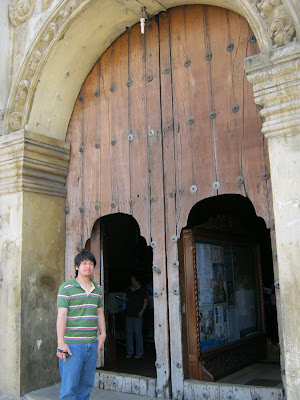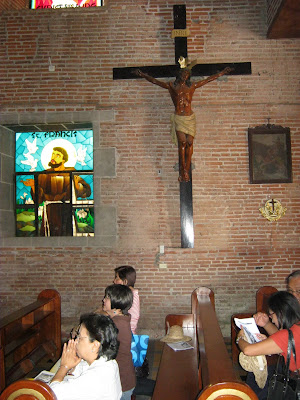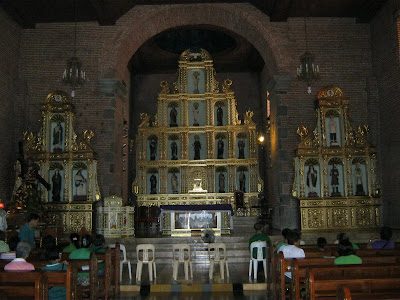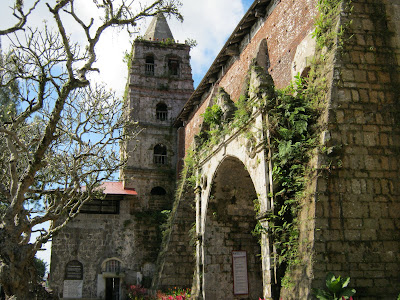
Diocesan Shrine of Our Lady of Turumba, Parish of St. Peter of Alcantara in Pakil, Laguna
The second main leg of this spiritual journey brought us to the Diocesan Shrine of our Lady of Turumba in Pakil, Laguna.
Under the Diocese of San Pablo, Laguna, this church was declared a diocesan shrine in honor of the Lady of Turumba on October 19, 2006 in commemoration of the 330th founding anniversary of the San Pedro de Alcantara parish.

Statue in honor of Pakil’s native son: Marcelo Adonay acclaimed as a prince of church music in the country

The church’s centuries-old front door

The group prayer continues

Side altar


The La Pieta, the Evangelists and artwork on biblical stories are seen at the church dome



Stigmata

Holy oils and other religious items are made available at the church

Stairway leading to the second floor chapel

The view of the town plaza from the church upper floor

Garments of the Lady of Sorrows

View from the church balcony

The Turumba chapel
Next stop – Liliw, Laguna.
Nestled at the northwest slopes of Mount Banahaw, the natural boundary of Tayabas (now Quezon) and Laguna, Liliw stands beside the banks of a river with the same name, bounded by the towns of Nagcarlan, Majayjay and Magdalena.
According to folklore, the town of Liliw got its name from a singing bird that perched on a bamboo pole raised by Gat Tayaw, the town’s legendary founder.
However, during the Spanish and American colonial periods, Liliw was actually known as “Lilio” because the Spaniards and the Americans had difficulty in pronouncing the letter “w”. It was only in 1965 that the name “Liliw” was formally adopted by the Municipality.

As a settlement during the Spanish colonial period, Liliw residents were evangelized in 1578 by Franciscan missionaries Juan de Placensia and Diego de Oropesa. The town remained a dependency of Nagcarlan until 1605 when it was assigned its first permanent minister, Fray Miguel de San Lucas.
Under the patronage of St. John the Baptist, the Liliw parish and town celebrates its feast day on August 29, a date marking the martyrdom of Christ’s humble cousin and precursor.

Picture of the Liliw Church and town of old

The group prayer continues

The Church’s three restored retablo altars
The church structure as well as the parochial rectory is primarily made up of adobe blocks and clay bricks. In 2007, then parish priest Rev. Fr. Philip B. Atienza, inspired by an old document that described the original church design, started a massive restoration that led to the reconstruction of three retablo altars, a confessional and a hanging pulpit.

Capilla de San Buenaventura
An old image of Saint Bonaventure, well known Franciscan theologian, Cardinal-Bishop of Albano and Doctor of the Church is displayed for veneration in a small newly built chapel adjacent to the atrium of the church and rectory. In 1664, the image is said to have been witnessed by the parish priest and 120 persons to have wept and sweated blood.

Side trip along Liliw’s commercial district
From the church, the group decided to have lunch there at Liliw. That of course gave everyone the chance to see the bustling commerce and trade that put this town on the map.
Aside from being a popular destination for its cold mountain water resorts, Liliw is also known as the “Tsinelas (footwear) Capital of the Philippines rivaling Marikina City of metropolitan Manila. There are numerous footwear shops along the main streets of Liliw where one can bargain hunt and haggle for a good price.
Similarly well known are Liliw’s lambanog (coconut sap alcoholic beverage), Uraro biscuits and various leather and fiber products.

OTOP – One Town, One Product concept

Liliw and Footwear synonymous to each other!

Local vendor sells Pako

Mt. Banahaw and Mt. Cristobal provide a magnificent background to the figure of the Blessed Mother
Waiting for the rest to come back from lunch gave me a lot of time to appreciate the beauty of Laguna’s natural surroundings. Taking cue from Bro. Terence’s magnificent shots of the Blessed Virgin statue beside the Liliw church, I took some of my own with the two great mountains of Banahaw and Sto. Cristobal as the stunning background.

Mama Mary beside the church tower
Next stop – Nagcarlan
As a young boy, I had many good memories of Nagcarlan. During my elementary years in St. Mary’s College, this area was often a destination for school field trips and Cub Scout camping activities. In this town, we continued our spiritual pilgrimage with a visit to the church of St. Bartholomew.

St. Bartholomew Parish in Nagcarlan, Laguna

St. Bartholomew’s altar

Statues of the Immaculate Mary with Sta. Catalina of Sena and Sta. Ana

In this station we remember as Jesus was nailed on the cross

A relief painting depicting the purification of souls in purgatory before entering God’s heavenly kingdom
From Nagcarlan, we retraced our travel route passing by the town of Liliw to go to the Municipality of Majayjay. Our travel destination - the remarkable parish church of St. Gregory the Great.

St. Gregory the Great Parish in Majayjay, Laguna
Designated a national treasure by virtue of Museum Declaration No. 2, dated July 31, 2001, the parish church of San Gregorio Magno commands a clear view of the hilly town and the Laguna de Bay from a distance. Despite some alterations on the walls, the church interior’s retablos and azulejo-tiled floor have been well preserved. I didn’t get to see it but access to the bell tower has supposedly been made easier with cement steps. This access way is also said to lead to the so-called ‘langit-langitan’, a catwalk above the ceiling which in turn proceeds to the crossing over the transept.
Originally built by the Augustinian friars out of bamboo and nipa material at Sitio May-it after the conquistador Salcedo pacified the natives in 1571, the first parish church was burned in 1576. It was reconstructed by the Franciscans in 1578 but caught fire a second time around in 1606. The present stone church was put up from 1616 – 1649; partly burned again in 1660 and repaired in 1707. It then underwent expansion and several repairs over the next two centuries due to damages from passing storms. The American colonialists used the church as a base during the Philippine-American War, again undergoing repairs in 1912.

Plant covered buttresses support the church walls

St. Gregory’s bell tower

A statue of the Laguna’s greatest son Jose Rizal nearby

Side entrance

The final Stations of the Cross are reflected over inside St. Gregory’s

The church altar and chancel
Our Visita Iglesia has already brought us to a lot of places but the journey is far from over.
Onwards to Lucban!



No comments:
Post a Comment